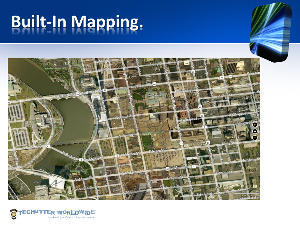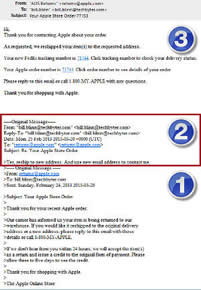Are We Dealing Any Better with Windows 8 Hate?
I had the opportunity this week to share my thoughts about Windows 8 with both the Licking County Computer Society and the Columbus Computer Society. Although Windows 8 continues to be the operating system that has attracted what I consider to be an unreasonable about of fear and loathing, it has a lot of promise and I like it.
Click any of the smaller images for a full-size view. Press Esc to dismiss the large image.
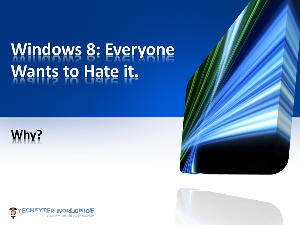 I was asked, "Do you love it?" No. I've never loved any operating system. I reserve that for my wife, kids, and cats. But it many ways its better than Windows 7 and that's saying something.
I was asked, "Do you love it?" No. I've never loved any operating system. I reserve that for my wife, kids, and cats. But it many ways its better than Windows 7 and that's saying something.
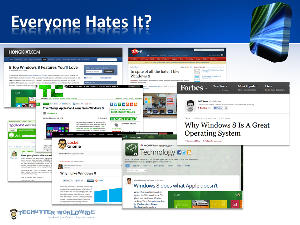 Computer pundits, after widely panning Windows 8, have begun to develop some respect for it.
Computer pundits, after widely panning Windows 8, have begun to develop some respect for it.
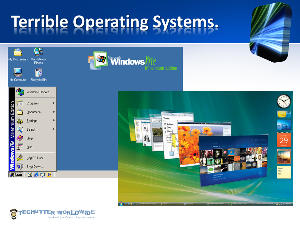 Microsoft has had its share of horrid operating systems. Windows Me (Millennium Edition) was both useless and ugly, something that even Microsoft admitted within a year or so of its release. Windows Vista, although pretty, was still useless. I wanted to like Vista and tried for at least 18 months before retreating to XP.
Microsoft has had its share of horrid operating systems. Windows Me (Millennium Edition) was both useless and ugly, something that even Microsoft admitted within a year or so of its release. Windows Vista, although pretty, was still useless. I wanted to like Vista and tried for at least 18 months before retreating to XP.
Windows 7 was Vista done the way Vista should have been done.
Windows 8 might be Windows 7 done better.
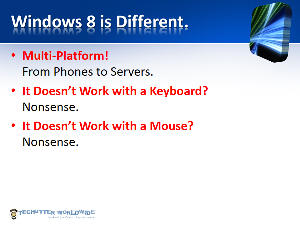 The challenge for Windows 8 is to convince people that the differences make things better.
The challenge for Windows 8 is to convince people that the differences make things better.
This is the first time anyone has tried to create an operating system that works on phones, servers and everything between – desktops, tablets, workstations, netbooks, and notebooks.
When I bought an Android tablet, I realized immediately why people who own tablets like them. I understood, several years after the fact, what Steve Jobs had in mind with the Ipad.
The Android tablet looked just enough like Windows to be confusing, though. It didn’t act like Windows and, when I returned to my Windows 7 desktop or notebook, I kept wanting to touch the screen.
All I got was smudges on the screen.
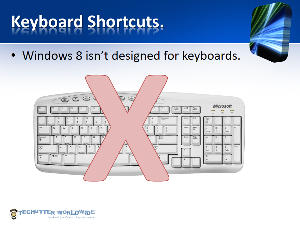 Perhaps the most ridiculous claim I've heard from detractors is that Windows 8 doesn't work with (or isn't intended to work with) keyboards and mice.
Perhaps the most ridiculous claim I've heard from detractors is that Windows 8 doesn't work with (or isn't intended to work with) keyboards and mice.
That is simply absurd and the truth will be self evident to anyone who actually sits down in front of a Windows 8 computer and, with an open mind, gives it a try.
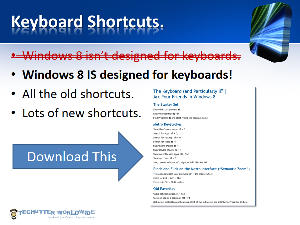 Most, if not all, of the old keyboard shortcuts are still present and there are lots of new ones, too.
Most, if not all, of the old keyboard shortcuts are still present and there are lots of new ones, too.
Those who like the efficiency of keeping their hands on the keyboard instead of reaching for a mouse will find that Windows 8 has robust support for keyboard shortcuts.
Download my Windows 8 shortcut document.
The Metro interface is optimized for tablets but the Metro interface is only part of Windows 8. If you have a desktop or notebook computer, you'll spend your time on the Desktop and it has changed very little since Windows 7. Except for the absence of the Start Menu.
For some reason, that scares a lot of people. In fact, I was concerned about it a year ago and that concern continued until I actually used Windows 8 on a production system.
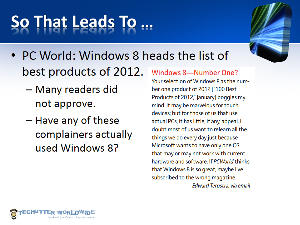 Because so many people misunderstand that the presence of Metro doesn't demand that desktop and notebook owners use Metro, there are lots of silly complaints. For example, when PC World named Windows 8 as one of the best products of 2012, one reader said that the choice “boggles my mind”. He continued, “For those of us who use actual PCs, it has little, if any appeal,” and then says that users must “re-learn everything”.
Because so many people misunderstand that the presence of Metro doesn't demand that desktop and notebook owners use Metro, there are lots of silly complaints. For example, when PC World named Windows 8 as one of the best products of 2012, one reader said that the choice “boggles my mind”. He continued, “For those of us who use actual PCs, it has little, if any appeal,” and then says that users must “re-learn everything”.
That kind of attitude elicits a sigh from me. So many of the complaints I’ve read or heard seem to indicate that the writer or speaker has never used Windows 8 but has decided to hate it anyway.
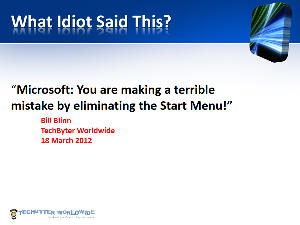 But, as I said, just a year ago I was in that same position.
But, as I said, just a year ago I was in that same position.
Without bothering to understand what Microsoft had in mind and without spending more than a few minutes per week working with Windows 8, I had concluded that Microsoft was making a terrible mistake by eliminating the Start Menu.
Although I now recognize that the Start Menu isn't necessary, eliminating it still may have been a mistake: A marketing mistake. Overall, though, Microsoft made the right decision because the new method really is better if you're interested in speed and efficiency.
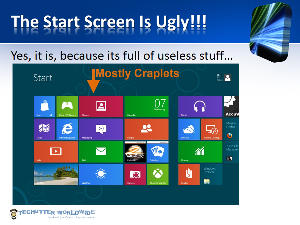 Windows 8 gets off on the wrong foot by shipping with an ugly Metro screen that’s filled mainly with useless apps. That’s easy to change, though.
Windows 8 gets off on the wrong foot by shipping with an ugly Metro screen that’s filled mainly with useless apps. That’s easy to change, though.
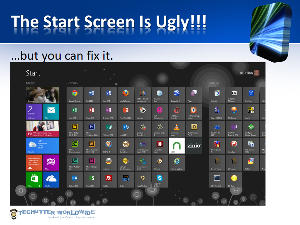 For the presentation, I spent about an hour to carefully arrange the Start Screen on the desktop so that I could show people what it looks like. I placed the Metro apps that I actually use on the left and then arrayed other tiles across the screen.
For the presentation, I spent about an hour to carefully arrange the Start Screen on the desktop so that I could show people what it looks like. I placed the Metro apps that I actually use on the left and then arrayed other tiles across the screen.
Doing this was actually a waste of time and I did it only for effect. In practice, the Start Screen is irrelevant on a desktop or notebook.
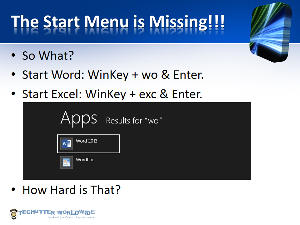 Yes, the Start Menu is missing from both Metro and the Desktop, but so what!
Yes, the Start Menu is missing from both Metro and the Desktop, but so what!
Tap the Windows key and start typing the name of the program you want to start. The program will appear and, when you press Enter, the program will Start.
That's right, you can start a program in seconds and without taking your hands off the keyboard.
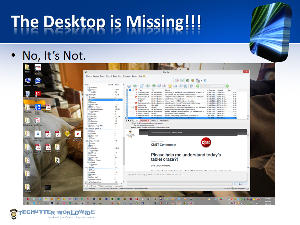 People say that the Desktop is missing, but it isn't and this is the primary reason why the Start Screen is irrelevant for desktop and notebook users: You can still pin applications to the Task Bar if you want to start applications by clicking them.
People say that the Desktop is missing, but it isn't and this is the primary reason why the Start Screen is irrelevant for desktop and notebook users: You can still pin applications to the Task Bar if you want to start applications by clicking them.
You can still place shortcuts to applications or documents on the desktop.
This took about 20 seconds to get used to.
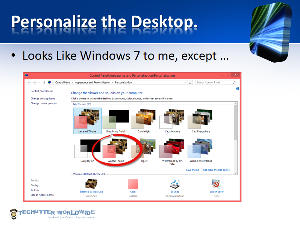 You can even personalize the Desktop much as you could with Windows 7 but if you have multiple computers and you use the same Microsoft Outlook login for all of them, you can synchronize passwords, Desktop backgrounds, and more across all the machines.
You can even personalize the Desktop much as you could with Windows 7 but if you have multiple computers and you use the same Microsoft Outlook login for all of them, you can synchronize passwords, Desktop backgrounds, and more across all the machines.
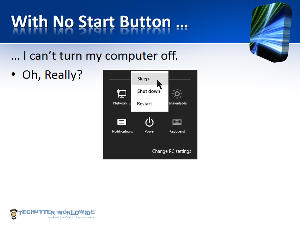 "But without the Start Menu, I can't shut down the computer!"
"But without the Start Menu, I can't shut down the computer!"
Remember when Microsoft was derided for placing the command to shut down the computer on the Start button? Now the same people who complained about having to use Start to shut the system down are complaining that they can't use Start to shut the system down.
With just a couple of keystrokes or mouse clicks, you'll have the ability to put the computer to sleep, shut it down, or restart it.
New Features in Metro
Metro apps exist for a variety of functions that will be useful and desirable when you're not sitting in a home or office. Some are useful even if you aren't outside. Some of the features simply duplicate functions that could already be done by other means.
Although it would be easy enough to open a browser and use one of the mapping services, a Metro app provides instant access to maps. Maps app also includes indoor maps for over 3,000 venues, including malls, universities, shopping districts, and airports.
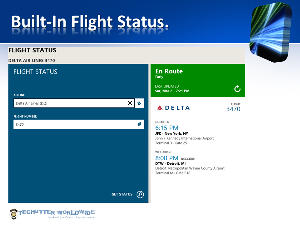 There's an app for checking the status of flights, too.
There's an app for checking the status of flights, too.
You could open a browser and select one of the websites that does this or, with a single click, you can open the built-in app.
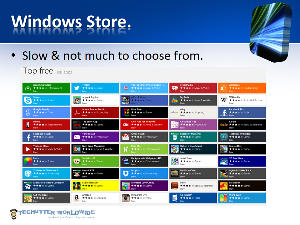 The Windows Store can't yet compete with Apple's or Android's stores and the download speed seems unreasonably slow but new apps are being added all the time and I would expect Microsoft to improve the speed sooner rather than later.
The Windows Store can't yet compete with Apple's or Android's stores and the download speed seems unreasonably slow but new apps are being added all the time and I would expect Microsoft to improve the speed sooner rather than later.
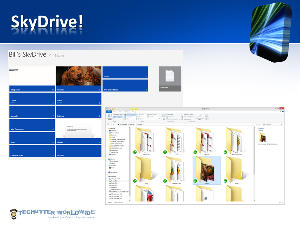 Although SkyDrive isn't new, it's a real plus for Windows 8. It's both a Metro application and a Desktop application. For use on the desktop, you need to download a program. Synchronize files with all your devices.
Although SkyDrive isn't new, it's a real plus for Windows 8. It's both a Metro application and a Desktop application. For use on the desktop, you need to download a program. Synchronize files with all your devices.
The price is reasonable, too:
7GB - Free.
Add
20GB for $10 per year.
Add 50GB for $25 per year.
Add 100GB for $50 per year.
Windows 8 Will Change the Hardware Landscape
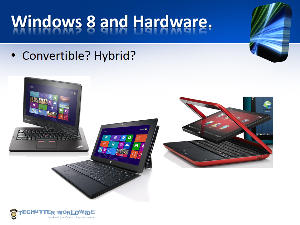 Acer and Asus announced recently that they will stop manufacturing netbook computers. With Ipads, Android tablets, and now Windows tablets, netbooks have been on the endangered list for a long time.
Acer and Asus announced recently that they will stop manufacturing netbook computers. With Ipads, Android tablets, and now Windows tablets, netbooks have been on the endangered list for a long time.
The Metro interface is ideal for some tasks, such as reading magazines and books, playing games, and paging through long documents.
The Desktop interface is ideal for some tasks, such as writing and editing, working with spreadsheets, and modifying photos or videos.
The sweet spot for hardware seems to be computers that can be either a tablet or a notebook. Lenovo (left) and Dell (right) have some convertibles. The pricey Microsoft Surface Pro (center), which has received some highly positive reviews, also provides standard and tablet interfaces.
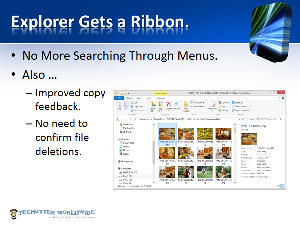 With Windows 8, even the Windows Explorer gets a ribbon. The new interface makes it easier to get to functions that you need.
With Windows 8, even the Windows Explorer gets a ribbon. The new interface makes it easier to get to functions that you need.
And finally there's no confirmation question when you select a file and tap the Delete key. This has been an annoyance for years because deleted files can easily be recovered from the Recycle Bin, the question is pointless.
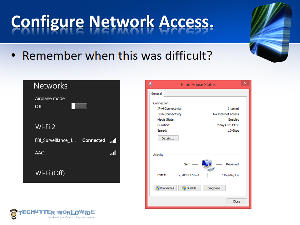 It used to be that traveling with a Windows computer was a challenge. If you wanted to use a hotel's wired or wireless connection, configuring the network settings could consume an hour or more. Because of that, I traveled with a Mac whenever Windows wasn't essential.
It used to be that traveling with a Windows computer was a challenge. If you wanted to use a hotel's wired or wireless connection, configuring the network settings could consume an hour or more. Because of that, I traveled with a Mac whenever Windows wasn't essential.
Windows 7 improved the process considerably and Windows 8 has made it even easier.
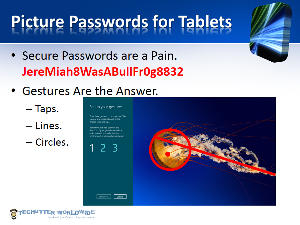 The primary disadvantage tablets have is the lack of a real keyboard so Microsoft provided for picture passwords on tablets. A picture password consists of any 3 gestures that you define and a gesture is a tap, a line, or a circle.
The primary disadvantage tablets have is the lack of a real keyboard so Microsoft provided for picture passwords on tablets. A picture password consists of any 3 gestures that you define and a gesture is a tap, a line, or a circle.
Imagine trying to type a password such as "JereMiah8WasABullFr0g8832" on a tablet.
Wouldn't it be easier to draw a straight line, draw a circle, and then tap the image? Or draw 3 lines? Or use 2 taps and a circle?
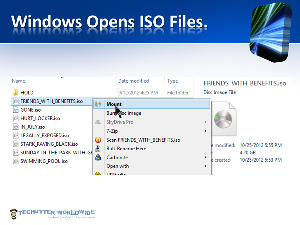 In the "neat but not a really big deal" category, there's the ability to mount ISO files directly from the Windows Explorer. There's no longer a need to add an extra application such as Virtual Clone Drive to mount an ISO.
In the "neat but not a really big deal" category, there's the ability to mount ISO files directly from the Windows Explorer. There's no longer a need to add an extra application such as Virtual Clone Drive to mount an ISO.
ISO files are similar to zip (compressed) files in that they can hold lots of other files. ISO files are also disc images that are used for installation programs and videos discs. If you need to work with an ISO image, you don't need to burn it to a disk.
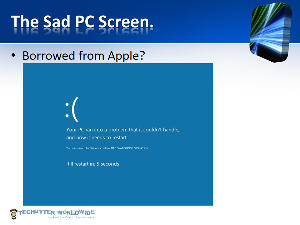 But, Microsoft, really did you have to borrow this silly idea from Apple? I have never seen this screen and had to find the image on the Internet.
But, Microsoft, really did you have to borrow this silly idea from Apple? I have never seen this screen and had to find the image on the Internet.
The blue screen of death is now a lighter, prettier blue but it provides virtually no useful information about what went wrong.
This is something that Microsoft should fix!
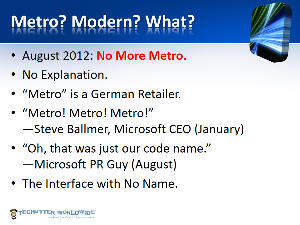 I have referred to the new interface as "Metro" and for now I plan to continue doing that. Until August 2012, "Metro" was the Microsoft battle cry and then suddenly it wasn't.
I have referred to the new interface as "Metro" and for now I plan to continue doing that. Until August 2012, "Metro" was the Microsoft battle cry and then suddenly it wasn't.
Apparently a German retailer objected to the use of their name as the name of Microsoft's new interface. Did they think that someone would confuse a store in Germany with an operating system? Did they think that people would believe they had acquired Microsoft or that Microsoft had acquired them?
No matter. What we now have, though, is essentially an interface with no name.
But it's a pretty interface.
- Columbus Computer Society (http://www.ccscmh.org/)
- Licking County Computer Society (http://www.lccsohio.org/)
Here's an Uncommonly Clever Fraud
Although an e-mail message I received this week was no harder to identify as a fraud than are most such messages, this one used a technique that made it stand out a bit from the standard frauds. This one tried to convince me that I was already engaged in a conversation with the sender. That's not uncommon, either. A lot of spam frauds include "RE:" in the subject line but this message went beyond that.
At the bottom of the message (1), the fraudster has created a message that purports to have been from the Apple store to me. It's dated nearly a month ago and says that my "item" is being returned to the warehouse and asks if I want to have it shipped to the original address or a new address.
The next section, and this is the clever part (2), is where I appear to have replied the following day.
Now, a month later, the new message (3) tells me that they have reshipped my "item(s)" to the "requested address" and displayed FedEx tracking number 71744.
I would expect to remember a conversation such as this, but if I didn't, then I would expect a list of the "item(s)" that are being shipped and I would expect the "requested address" to be shown. I would also expect a FedEx tracking number to be in the FedEx format (12 or 15 digits). Three tests. Three failures. It's a fraud.
But I wondered—where does the link go and what is the goal of the fraudster?
![]() Let's look. I used Windows PowerShell examine the URL (a Russian domain). By using PowerShell, it's possible to load the HTML from the website without having it activate any process on my computer.
Let's look. I used Windows PowerShell examine the URL (a Russian domain). By using PowerShell, it's possible to load the HTML from the website without having it activate any process on my computer.
The entire page consists of a single IFRAME that has another URL.
![]() So I used the same process with that URL, knowing that PowerShell wouldn't be able to display it because the file is a PHP file instead of an HTML file. PHP is a commonly used file type for websites.
So I used the same process with that URL, knowing that PowerShell wouldn't be able to display it because the file is a PHP file instead of an HTML file. PHP is a commonly used file type for websites.
The action failed in a way I hadn't expected.
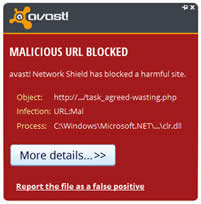 As it turned out, my computer would have been safe even if I had attempted to load the site with a browser.
As it turned out, my computer would have been safe even if I had attempted to load the site with a browser.
Avast recognized the URL as being a site that would attempt to serve malicious software and closed the connection immediately.
The fraudster didn't fool me and my computer has not been infected, but I wonder how many people who perhaps had returned something to Apple sometime within the past month or so saw this message, saw what appeared to be their earlier response, and unquestioningly clicked the link.
I have a motto that I use effectively in dealing with any message that arrives in my e-mail inbox:

Assume that anything you receive is fraudulent until proven otherwise; your computer will be much happier and so will you!
Short Circuits
An Interesting Week in South Korea
Banks and broadcasters in South Korea were all but shut down this week by a cyber attack that many quickly blamed on North Korea. But by most standards that attack was poorly executed and appears not to be up to North Korea's standards. North Korea may not have a lot but its cyber warriors are thought to be well trained and highly capable.
So who did it?
Bank ATMs were shut down. TV screens were blank. At the same time, the Korean Central News Agency quoted Kim Jong-un, who threatened to attack the South and the United States as the US and South Korea carried out joint naval training operations.
The more likely suspect, it seemed, is China and the Korea Communications Commission said that specifically, but later decided the information was incorrect and withdrew it.. So the question remains: Who did it?
There's speculation that North Korean cyber warriors have been trained in China but there's no proof to back up those claims and most of the experts who study these kinds of events express doubt that China has trained the North Koreans.
The malware involved in the attack surfaced about a year ago and has been dubbed "DarkSeoul". It's designed to maneuver around the protective applications used in South Korea. DarkSeoul's primary goal is to delete as many files as possible from the infected computers. The machines then crash and cannot be rebooted until the software is reloaded.
Earlier in the week, North Korea blamed the South and the United states for attacks on North Korean websites. South Korea has been cautious not to blame the North without clear proof. The "who did it" question that I keep asking probably won't have a clear answer for months and may never have a clear answer.
Feds Investigate Alleged Microsoft Bribes
The US Department of Justice may be calling on Microsoft again and this time the might bring the Securities and Exchange Commission along. Both agencies are investigating allegations that Microsoft bribed government officials in several countries, including China, Italy, and Romania.
If the bribes occurred, they would be a violation of the federal Foreign Corrupt Practices Act that makes it a crime to pay government officials to gain their business. The law was passed in the late 1970s.
Microsoft's Vice President and Deputy General Counsel, John Frank, wrote a blog post this week in which he noted that frequently such claims prove to be false. Still, said Frank, Microsoft takes such allegations seriously and the company will cooperate in any government inquiries.
Similarly, government officials refused to comment on the possible investigation but as an indication of the number of allegations that are made, consider that Microsoft is one of about 100 companies that are currently being investigated. If Microsoft is being investigated.
A Microsoft employee who had worked in China reportedly is the person who altered federal officials. Microsoft investigated the situation in China internally in 2010 and found no evidence of wrongdoing.

